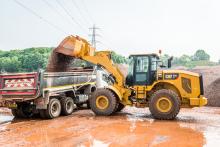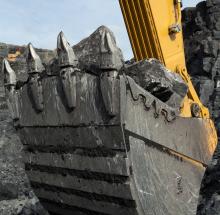
Caterpillar has notably added to its comprehensive large wheeled loader line-up for quarrying and heavy construction customers with the launch of the 988K XE – the U.S. giant’s first electric drive wheeled loader. Guy Woodford spoke to Todd Tuntland, Caterpillar product application specialist for large wheeled loaders, about the groundbreaking loader model and the other latest machines in the manufacturer’s extensive large wheeled loader range.
Despite his vast experience of working with a wide variety of quarrying, mining and heavy construction sector loading models, Todd Tuntland still gets excited about new machine launches. And Tuntland’s excitement about the 988K XE,
“It’s a very big milestone for us,” explains Caterpillar’s product application specialist for large wheeled loaders. “The 988K XE is built for efficiency. We’ve taken the mechanical transmission out of the 988K and we’ve replaced it with electric drive.
“We’ve tested the machine in quarry face work and quarry load and carry in the United States and in Europe [Amsterdam, The Netherlands], and the 988K XE offers an overall 25% efficiency advantage on the [2013-launched] 988K. We’ve also seen an efficiency advantage up to 49% in harsh, tough digging applications. These percentages show a very significant improvement in efficiency.”
Additionally, the 988K XE also generates up to 10% more load and carry productivity than the already high load and carry productivity of the 988K wheeled loader. “The productivity advantage is down to the model accelerating faster than the powershift 988K,” Tuntland explains.
With a standard near 53tonne operating weight (54.2tonnes in high lift) and powered by a Cat C18 ACERT 439kW EU Stage IV/Tier 4 Final engine, the 988K XE’s electric drive utilises switch reluctance (SR) technology and draws on Caterpillar’s more than 15 years’ experience of electric drive innovation, including four years of testing the model in tough loader applications.
The environmentally friendly 988K XE burns less fuel, thereby reducing its carbon footprint. The model’s annual fuel efficiency savings versus the mechanical drive 988K is equivalent to the same electricity used in 10 homes in a year, or the emissions of 3.5 passenger cars over the same period.
The 988K XE’s improved fuel efficiency means the model’s engine life is 3,500 hours longer than the 988K, with the fuel efficiency gains also considerably extending the life of the 988K XE’s electrical components. The 988K XE’s powertrain oil service is at 2,000 hours, compared to 1,000 hours on the 988K.
Of 988K XE operator comfort, Tuntland stresses that there’s minimal change in the cab compared to the 988K. Being a single speed range machine, the 988K XE can operate at any speed with virtual gears. Greater speed, smoothness and electric braking will, says Tuntland, make the model a better ride for operators.
The 988K XE has Cat Production Measurement (CPM) fitted as standard. CPM is a simple and accurate on-the-go payload scale allowing operators to deliver exact loads in order to work more efficiently.
Maintaining the correct tyre pressure on any wheeled loader is crucial for optimum model efficiency and productivity. The 988K XE’s fully integrated tyre pressure monitoring system allows operators to determine whether their loader’s tyres are properly inflated, by showing them current pressure settings for each tyre.
The 988K XE also benefits from Caterpillar’s new Cat Advansys GET (Ground Engagement Tools). Cat Advansys GET is built specifically for demanding high production applications, moving more material with less machine downtime, shift after shift. With Cat Advansys, customers can optimise the performance of their 988-994 wheeled loaders or 349-390 hydraulic excavators. Besides improving the adapter geometry for better retention and strength, Caterpillar changed the design of the Advansys tips in such a way that they self-sharpen as they wear. With tips that stay sharper longer, customers ensure better penetration, quicker load cycles and enhanced fuel efficiency - thanks to the most productive Cat GET system available. A new integrated retention system allows Advansys to be fully hammerless, for a faster, hassle-free and safer installation that requires no specific tooling. Cat Advansys GET will come in 14 different tip shapes so that customers can choose the one that best suits their application and material.
The Cat 988K XE is due to be showcased at
Caterpillar’s line-up of large wheeled loader models for higher regulated countries (HRC) range from the 45tonne 986K to the 240tonne 994K; and in lower regulated countries (LRC) from the 44tonne 986H to the 994K.
The 994K model currently available for North America & Europe customers is an LRC version, with a US Tier 4 Final version being made available in 2018. An EU Stage V compliant 994K model will be available in 2019. For quarrying and heavy construction customers, the 986K, 986H, 988K, 988K block handler and 990K wheeled loaders, ranging from 45tonnes to 81tonnes, are the ideal models.
Tuntland says Caterpillar HRC and LRC large wheeled loader models share the same multiple feature set.
“Our key focus is on achieving the lowest cost per tonne and lowest total cost of ownership for our customers. We’re the industry leader on this as the wider range of products that we offer means we can really size the right machine for the job. When you do that you get the lowest cost. For example, in a lot of cases we have two loaders that can match a haul truck. Depending on your production needs, your application and your site characteristics, we can take from our product line and give you the lowest cost per tonne.
“Large wheeled loaders are very, very productive and efficient in quarry applications where you have good underfoot and well shot material. They can provide a lower cost than other loading tools in those applications.
“It’s very important that we offer highly durable and reliable machines, because if your quarry pit loader goes down, everything else does as well.”
Tuntland explains that all latest series Caterpillar large wheeled loaders offer reduced fuel consumption compared to predecessor models, after the global equipment manufacturing giant acted on key customer concerns over their sizeable fuel costs.
“We didn’t do just [EU Stage IV] Tier 4 Final. We did so much more. To put it simply, less RPM is less fuel. So we took all our engines and we slowed them down. We reduced high idle, rated speed and low idle. Then we updated all our hydraulics with Positive Flow Control (PFC). This meant we only power or stroke the pump when we need it. When we don’t need it, we don’t consume power.
“We’ve also added Performance Series buckets across our large wheeled loader range. We’ve lengthened the [bucket] floor, made it flat, opened up the throat and changed the set-back angle. Just by doing that we can make our machines more productive and more efficient, because the less time you spend doing the dig, the less fuel you’re going to burn.”
Tuntland says Caterpillar’s K Series large wheeled loaders are designed for easier operator entry and exit. He continued: “A rear vision camera comes as standard on the models, and we offer the Cat Detect system [a radar system to give operators a better indication of what’s in their rear path] as an option. Ground level service is another important feature of all our latest large wheeled loaders.”
Tuntland stresses that Caterpillar’s ability to give a machine a productive second and third life is vitally important in achieving a lowest possible total cost of ownership. “We design into our machines a capability to rebuild them; to re-use our structures in a second life, and, depending on the application, possibly even a third. A powertrain rebuild can be done at a fraction of the cost of buying a new machine. This means that not only do you get a good cost upfront, in lives two and three you gain a significant advantage through a lower cost per tonne. Our dealers and servicing capability make all this happen.”
Tuntland notes that while in recent years customers in some markets had been keen on having their large wheeled loading fleet remanufactured, the new machine buyers’ market was still relatively healthy. “I think going forward we may see more new technology, and customers want the latest and greatest tech. There’ll be a balance between demand for remanufactured models and new purchases, as customers focus on what their priorities are.”
Of future Caterpillar large wheeled loader models, Paulo Oliveira, the company’s global marketing manager for wheeled loaders, adds: “Customers can expect more efficiency, more safety and more operator-friendly features that improve their performance.”








